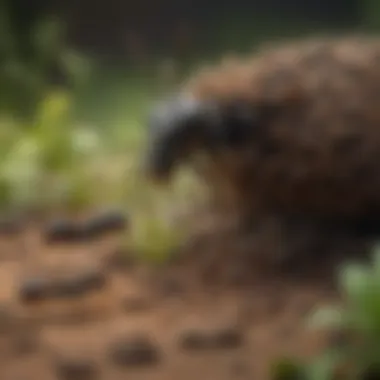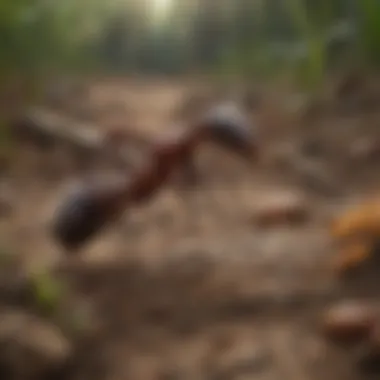Understanding the Best Ant Colonies for Pest Control


Intro
Ants play crucial roles in ecosystems. They are often misunderstood as mere pests. However, their presence can offer insights into managing other pests. Identifying beneficial ant colonies can transform pest management strategies for homeowners. Understanding ant behaviors and habitats provides a foundational base for effective control measures.
The following sections will delve into:
- Common household pests and how ants can help.
- Signs of ant infestation and their implications for pest control.
- Prevention methods to minimize pest sightings.
- DIY pest control solutions that utilize natural resources and techniques.
Through this knowledge, homeowners can harness the ecological significance of ants, enhancing both pest management and ecological health.
Prolusion to Ant Colonies
Ant colonies represent intricate social structures that are integral to various ecosystems. Understanding these colonies is essential when considering their roles in pest management. In this section, we explore what constitutes an ant colony and examine why ants are crucial for ecological balance. This foundational knowledge will benefit homeowners and enthusiasts, equipping them with insights to address pest control effectively.
Defining Ant Colonies
An ant colony is defined as a community of ants that live together, working collectively for survival. Each colony typically consists of one or more queens, numerous worker ants, and male ants, depending on the species and the season. The queen's primary role is reproduction, while the worker ants care for the queen's offspring, forage for food, and maintain the nest. This division of labor enhances the colony's efficiency and resilience.
Colony size can vary greatly. Some can have a few hundred individuals, while others may host millions. The interactions within the colony are guided by pheromones, which are chemical signals that ants use for communication. These signals play a crucial role in coordinating activities such as foraging and defense.
Importance of Ants in Ecosystems
Ants play multiple roles in their environment that are often undervalued. They contribute to soil aeration, decomposition, and nutrient cycling, all of which enhance soil health and fertility. Moreover, ants assist in controlling pest populations, acting as predators to various insects that might otherwise become nuisances in homes and gardens.
"Ants can be considered nature's pest control agents, maintaining balance within ecosystems."
By preying on pests, they limit the prevalence of harmful insects, thus benefiting agricultural practices and garden maintenance. Additionally, ants establish mutualistic relationships with other organisms, such as aphids. They protect aphids from predators in exchange for honeydew, a sugary substance produced by aphids.
In summary, recognizing the ecological importance of ants helps in forming effective pest management strategies. Homeowners can leverage the natural behaviors of these insects to create healthier and more sustainable living environments.
Classification of Ant Species
Understanding the classification of ant species is crucial in pest management. Different species exhibit distinct behaviors, habitats, and roles in their ecosystems. By classifying ant species, homeowners can better understand their pest control needs and the benefits different ants can bring to their environments. Effective pest management depends on recognizing the specific characteristics of the species at play. This knowledge not only aids in identifying any potential problems but also highlights which species could serve a beneficial purpose in pest control.
Carpenter Ants
Carpenter ants, known scientifically as Camponotus species, are large and black or bicolored insects. They prefer wood, often nesting in decayed or water-damaged areas. Their ability to excavate wood creates galleries that can weaken structures. However, their presence can indicate moisture issues within the home. Being vigilant about this is essential to prevent far more damaging infestations by other pests.
In terms of pest management, carpenter ants can be beneficial as they control other insect populations, like aphids and caterpillars. Homeowners should regularly inspect wooden structures for signs of these ants. If present, addressing moisture problems and sealing potential entry points is vital.
Fire Ants
Fire ants, primarily from the Solenopsis genus, are recognized by their aggressive behavior and painful stings. They build large mound nests in sunny, open areas. Fire ants can pose a risk to both humans and pets due to their aggressive foraging behavior. They also damage crops and gardens by their feeding habits.
While problematic, fire ants can actually contribute to pest management by preying on other insects. To manage fire ants, homeowners should consider baiting methods. This allows for effective control without harming non-target species. Regular monitoring and timely treatment are necessary to minimize the risks associated with them.
Pavement Ants
Pavement ants, known as Tetramorium caespitum, are small and dark brown, often found in cracks of sidewalks and driveways. They are notable for their nesting habits, as they thrive in urban environments. These ants can forage for a variety of food, including grease and sugars. They are generally harmless but can become a nuisance when they invade homes, especially seeking food sources.
In terms of pest control, pavement ants contribute to the ecosystem by aerating the soil. Homeowners should take proactive measures to seal entry points and keep food stored securely. This will help prevent infestations from becoming a larger issue.
Field Ants
Field ants, belonging to various species within the Formica genus, typically create nests in open fields or forests. They are usually black or reddish and have a smooth appearance. Field ants can be beneficial as they feed on the larvae of various pests, which helps to control their populations.


Their presence is generally not harmful. However, they can occasionally invade homes when searching for food. Homeowners can manage field ant populations by ensuring food sources are contained and by eliminating nesting sites close to structures. Regular landscape maintenance can also deter field ants from setting up near homes.
Each species offers unique insights into pest management strategies. Understanding these distinctions allows homeowners to adopt measured approaches in keeping their environments thriving and pest-free.
Key Characteristics of Successful Ant Colonies
Ant colonies play a vital role in pest management and ecosystem services. Understanding their key characteristics can help homeowners make informed choices in utilizing these natural allies against unwanted pests. Successful ant colonies possess certain traits that enhance their effectiveness in fulfilling ecological roles.
Colony Structure
The structure of an ant colony is essential for its efficiency and resilience. Ant colonies typically consist of a queen, workers, and sometimes drones. The queen is responsible for reproduction, while the worker ants undertake various tasks, like foraging and nest maintenance.
This division of labor is crucial. It allows ants to specialize in tasks, improving efficiency. For instance, when faced with threats, worker ants can mobilize quickly to defend their nest or protect the queen. This hierarchical structure not only facilitates better resource management but also enhances the colony's ability to adapt to environmental changes.
Communication Strategies
Ants communicate using pheromones, which are chemical signals that convey different messages. This communication is vital for the coordination of activities such as foraging and defense. For example, when a worker ant discovers food, it releases a specific pheromone trail back to the colony. Other ants can follow this trail, leading to efficient foraging and resource allocation.
Effective communication also plays a role in alarm signals. If danger is detected, a specific pheromone alerts the colony to mobilize other workers for defense. The intricacies of these communication strategies ensure that the colony operates cohesively, highlighting an important characteristic of successful ant colonies.
Foraging Behavior
Foraging behavior varies significantly among ant species, affecting their success in pest management. Some ant species, like the Pavement Ant, have adapted to urban environments, showing remarkable efficiency in locating food sources. Their ability to forage extends beyond mere food collection; they also prey on various pests, including cockroaches and termites, helping control these populations naturally.
Moreover, ant foraging techniques are often collaborative. Worker ants may form larger groups to transport larger food items back to the nest. This cooperation not only maximizes the resources but also minimizes the risks associated with foraging. By understanding these behaviors, homeowners can effectively integrate ant colonies into their pest management strategies.
The key characteristics of successful ant colonies — colony structure, communication, and foraging — provide insight into how these insects function and thrive in various environments. Their ecological significance can enhance natural pest management solutions.
Ant Colony Habitats
Understanding ant colony habitats is essential for anyone interested in pest management. Ants have specific preferences for where they build their colonies, and knowing these preferences can help in managing their populations effectively. Ant habitats can influence their behavior, reproduction, and role in the ecosystem.
Preferred Environments
Ants are versatile creatures. However, they thrive best in certain environments. Common preferred environments for ant colonies include:
- Forests: Many species, such as carpenter ants, prefer the shaded environment of forests. The cool, moist conditions are ideal for nesting.
- Lawns and Gardens: Certain species like the pavement ant often inhabit gardens and lawns where there is ample soil.
- Urban Areas: Fire ants are notorious for adapting to urban landscapes, as they find plenty of food sources in human habitats.
These environments support the life cycle of ants, offering necessary resources like food and shelter. For example, gardens provide both vegetation and organic matter, which can attract many pest species. Understanding this habitat preference can be significant for homeowners.
Nesting Locations
The choice of nesting locations is influenced by the ants’ needs for moisture, temperature, and food availability. Common nesting locations include:
- Under Rocks: Many species dig their nests under rocks or other debris, creating a microenvironment that offers protection.
- Inside Wood: Carpenter ants often locate their nests within decaying wood, where they can feed on the fungi. This makes it important for homeowners to inspect wooden structures for signs of nesting.
- Soil Mounds: Fire ants are known for their visible mounds, which can indicate their presence. These nests allow them to create a controlled atmosphere for their colony.
Each location has its advantages, but understanding these nuances can help homeowners identify pest problems early on. By keeping an eye on common nesting behaviors, effective measures can be taken against unwanted infestations.
Knowing where ants prefer to live and nest can provide homeowners with critical information for effective pest control measures.
Benefits of Ant Colonies in Pest Management
Ant colonies play a crucial role in pest management. Understanding their benefits can greatly assist homeowners in establishing effective strategies. They contribute to pest control actively and passively within various environments, influencing household ecosystems.
Natural Pest Control Agents
Ants act as natural pest control agents in several ways. They feed on a wide range of pests such as termites, aphids, and caterpillars. This predatory behavior naturally reduces pests that can damage plants and structures. A colony of fire ants, for instance, can help manage various insect populations, saving homeowners from potential infestations.
Moreover, some ant species cultivate relationships with other pest species, like aphids. They protect these bugs from predators in exchange for the honeydew they produce. This relationship, while seemingly symbiotic, can help regulate the population of certain pests, allowing for a healthier ecosystem.
- Key benefits include:
- Reduction of harmful insect populations
- Diverse diets that target various pests
- Indirect pest management through complex relationships with other species


Soil Aeration and Nutrient Recycling
Ants also contribute significantly to soil health. Their tunnels aerate the soil, promoting better air circulation. This aeration improves water infiltration and provides an environment conducive to plant growth. The movements of ants through the soil create pathways that allow roots to penetrate more efficiently.
In addition to aerating the soil, ant colonies help in nutrient recycling. They collect organic materials like dead insects and decaying plant matter, breaking them down into nutrients that enrich the soil. This process increases the bioavailability of essential nutrients for plants, leading to more vigorous growth and resilience against pests.
"Ants, through their foraging and nesting habits, enrich the soil, contributing to the overall health of garden ecosystems and supporting plant growth."
- Benefits for soil health are:
- Enhanced aeration allowing roots to thrive
- Nutrient cycling that replenishes soil quality
- Stimulating microbe activity beneficial for plant health
Understanding the benefits of ant colonies in pest management aids in developing sustainable pest control strategies at home. These persistent creatures not only control pests but also promote a thriving garden environment.
Interactions Between Ant Species
Ant species do not exist in isolation. Their interactions greatly influence their success and their impact on ecosystems. Understanding these interactions is essential for homeowners looking to use ants as a means of pest management. Key elements include symbiotic relationships and competition for resources, both of which shape the behavior and population dynamics of ant colonies. Identifying these dynamics allows for more informed pest management strategies.
Symbiotic Relationships
Symbiosis among ant species often manifests in various forms such as mutualism, commensalism, and parasitism. A prominent example of mutualism involves ants and aphids. In this relationship, ants protect aphids from predators while feeding on the honeydew that aphids produce. This relationship benefits the ant by providing a food source while allowing the aphid population to thrive, which can increase pest pressure on plants.
Ants have also been known to engage in commensalistic interactions with fungi. Leafcutter ants cultivate specific fungi by providing them with leaves to grow on. The fungi, in turn, serve as a vital food source for the ants. These complex relationships create a network of dependencies crucial for colony survival.
"The intricate relationships between ants and other organisms exemplify the interconnectedness of ecosystems."
Understanding these symbiotic relationships allows homeowners to recognize beneficial ant behaviors and identify how they can bolster pest control efforts naturally. After all, promoting beneficial relationships may not only help to manage harmful pests but also enhance overall ecosystem health.
Competition for Resources
Competition is a fundamental aspect of ant behavior and interactions. Different ant species often vie for the same food sources or nesting sites. This competition can lead to aggressive encounters or even the establishment of hierarchies among colonies. For instance, aggressive species like the red imported fire ant often dominate areas where they compete with native ant species, significantly affecting local ant biodiversity.
The implications of these interactions are significant for pest management. Homeowners may find that certain ant species suppress pest populations while others do not. This knowledge can inform decisions about which ant species to encourage within a garden or home environment. Properly understanding which species compete effectively can lead to better control against unwanted pests.
Considering both symbiotic relationships and competition for resources provides valuable insights into the ecological role of ants. By leveraging these understandings, homeowners can create harmonious environments while effectively managing pest issues.
Ant Behavior and Adaptations
Understanding ant behavior and adaptations is crucial for effective pest management. Ants are not just simple insects; they demonstrate complex behaviors and strategies that have evolved over millions of years. These behaviors directly impact their role in ecosystems and their effectiveness as natural control agents against pests.
Foraging Techniques
Foraging is a primary activity for ants that directly relates to their survival and the dynamics of pest control. Different ant species employ various foraging techniques, adapting their methods based on environmental conditions, availability of resources, and competition.
- Trail Marking: Many ants, such as the common pavement ant, use pheromones to create trails, guiding others to food sources. This communication strategy ensures efficiency and maximizes food collection.
- Team Foraging: Some species, like fire ants, employ mass foraging techniques. When a food source is located, numerous workers converge on the area, overwhelming any potential competitors and ensuring quick resource acquisition.
- Niche Specialization: Certain ants exhibit specialization in foraging habits. For instance, carpenter ants are known to forage primarily at night, reducing competition with diurnal species and exploiting nocturnal prey effectively.
Adopting these foraging strategies not only aids in food acquisition but also enhances their effectiveness in managing pest populations. They target other insects, larvae, and even small animals, contributing to a balanced ecosystem.
Defense Mechanisms
Ants also possess a range of defense mechanisms that are critical for the survival of their colonies and their role in biology. These adaptations allow ants to protect food sources, their nests, and themselves from potential threats, including other insects and human interventions.
- Chemical Defenses: Many ants can excrete formic acid and other chemicals as a defense. Fire ants, for example, inject venom that can cause painful stings, deterring predators and protecting their territory.
- Cooperative Defense: In species like the leafcutter ant, when faced with threats, soldiers will rally to defend the colony. Their size and strength make them formidable protectors against intruders.
- Camouflage and Nesting Strategies: Some ants adapt by choosing nesting sites that are less noticeable or that blend into the environment, thereby reducing the chances of predation. Specific ant species will also alter their foraging times to avoid predators.
These defense mechanisms are essential not just for the ants' existence but also for their role in pest management. Strong defense means ant colonies can thrive and sustain their population, allowing them to continue controlling other pests effectively.


In summary, the behavior and adaptations of ants significantly influence their role in pest management. Understanding these patterns is key for homeowners aiming to use ants as natural pest control solutions.
Challenges in Ant Colony Management
Ant colonies play a complex role in pest management strategies. However, managing these colonies is not without its challenges. Understanding these difficulties is paramount for homeowners and pest management professionals. Successful management of ant colonies requires a nuanced approach to minimize conflicts with human activities while maximizing their ecological benefits.
Resistance to Control Measures
One significant challenge in ant colony management is their increasing resistance to various control measures. Ants exhibit adaptability that allows them to develop strong resistances to pesticides and other chemical treatments. This phenomenon is particularly evident in species like the red imported fire ant, which often become less susceptible to traditional baits over time. Homeowners may find that their efforts to eliminate infestations become less effective, leading to frustration.
The development of resistance can stem from several factors:
- Genetic Variability: Some ants possess genetic traits that help them survive pesticide exposure. This can lead to entire colonies becoming resistant over successive generations.
- Inadequate Application: Often, the application methods of these control measures are not optimal. Homeowners may apply treatments in ways that do not reach the colony effectively, allowing ants to survive and propagate.
- Misuse of Products: Using multiple products simultaneously can also lead to resistance as ants frequently encounter different chemicals.
The implications of resistance are substantial. It can drive up costs for pest control and result in the persistence of the targeted ant species. Thus, understanding the biology and behavior of these ants is crucial in tailoring effective management strategies.
Environmental Changes
Another pressing factor affecting ant colony management is environmental change. Fluctuations in climate, urban development, and habitat destruction can alter the behavior and distribution of ant species. For example, warmer temperatures may expand the range of certain ant colonies, pushing them into areas where they might not have previously existed.
Several environmental changes impact ant colonies:
- Climate Change: Rising temperatures can affect reproduction rates and colony survival. Some species thrive under increased heat, while others may decline, altering local ecosystems.
- Urbanization: The encroachment of cities can disrupt natural habitats, forcing ants into closer contact with human settlements. This can lead to infestations in homes and businesses.
- Natural Disasters: Events like floods and fires can decimate colonies, but they also can trigger new colony formations as survivors seek refuge in human structures.
These changes necessitate adaptive management strategies that consider not only the ants themselves but also their surrounding environment. Homeowners must be aware of how such alterations can impact their pest management efforts.
"Awareness of both ant behavior and environmental dynamics is essential for developing effective management solutions."
Sustainable Practices in Ant Management
Sustainable practices in ant management are essential for maintaining ecological balance while effectively controlling pest populations. These practices aim to reduce reliance on chemical pesticides, which can disrupt not only ant colonies but also other beneficial organisms within the ecosystem. Homeowners should consider methods that prioritize long-term viability over short-term solutions.
Integrated Pest Management Solutions
Integrated Pest Management, often referred to as IPM, is a holistic approach that combines different strategies to manage pests, including ants, in an environmentally responsible manner.
- Monitoring: Regular monitoring of ant activity helps in understanding their behaviors and movement patterns. Homeowners can track when and where ants appear, allowing for more targeted interventions.
- Cultural Practices: Simple changes in the home environment, such as proper sanitation, can deter ants. This includes sealing food containers, cleaning crumbs, and removing food sources that attract them.
- Biological Controls: Encouraging natural predators of ants, such as birds or certain insects, can help to keep ant populations in check without harmful chemicals.
- Physical Barriers: Implementing physical barriers like screens, caulking, or even using diatomaceous earth can prevent ants from entering homes. This method is straightforward and doesn’t involve any chemicals.
"The key to successful pest management is understanding the ecosystem around us and making informed decisions."
Eco-friendly Ant Control Methods
Adopting eco-friendly ant control methods promotes a healthier home environment and minimizes negative impacts on the ecosystem. Here are several effective approaches:
- Natural Repellents: Common household items such as vinegar, lemon juice, and essential oils can serve as natural repellents. Spraying a mixture of these substances around entry points can create a barrier that ants avoid.
- Boric Acid and Sugar Baits: Using baits made from boric acid mixed with sugar can attract ants while being less harmful to non-target organisms compared to traditional pesticides. Ants consume the bait and carry it back to the colony, which can help eliminate the source.
- Nematodes: Beneficial nematodes are microscopic worms that can effectively target and kill ants. They are safe for humans and pets, making them an ideal choice for eco-friendly pest management.
- Organic Pesticides: If chemical solutions are necessary, opting for organic pesticides that have minimal environmental impact is crucial. Products containing natural ingredients can effectively control ant populations without harming the surrounding ecosystem.
Implementing these sustainable practices not only aids in ant management but also contributes to a healthier environment. Homeowners who are proactive in using these strategies can expect a more balanced approach to pest control.
Closure and Future Directions
As we move forward, it is crucial to acknowledge the need for sustainable practices when managing ant colonies. Homeowners should consider natural methods that fit within the framework of integrated pest management. This includes recognizing the beneficial aspects of certain ant species while also understanding when and how to intervene if they become problematic.
Research and innovation in ant behavior and their interactions can lead to enhanced pest management techniques. Keeping an open mind towards these complex social insects offers new ways to balance pest control with ecological preservation.
Summary of Key Points
- Ants play a significant role in pest management, serving as natural predators to many garden pests.
- Understanding the behaviors and habitats of various ant species allows for informed pest control strategies.
- Sustainable methods are vital for effective ant management, emphasizing the importance of integrated pest management practices.
Research Gaps and Opportunities
Despite the valuable insights gained from studying ant colonies, there remain many gaps in research that could enhance our understanding and usage of ants in pest management.
- More targeted studies on specific ant species and their impacts on local pest populations are necessary. This can guide homeowners in selecting the best species for their specific environments.
- Investigating the effects of urbanization on ant behavior and nesting can yield valuable information on how to manage ant populations in city settings.
- Opportunities exist for developing eco-friendly pest management products that incorporate ant behaviors and interactions. This can further improve relationships between humans and these insects.















